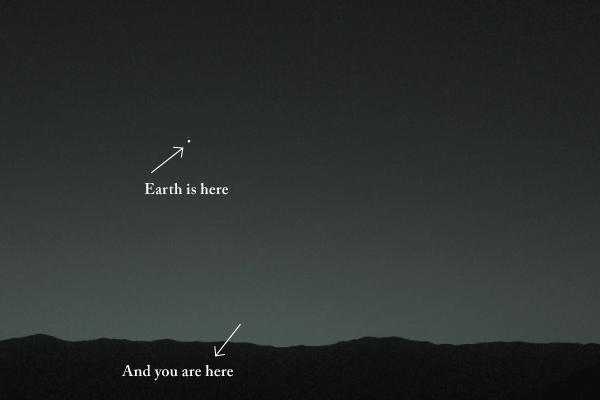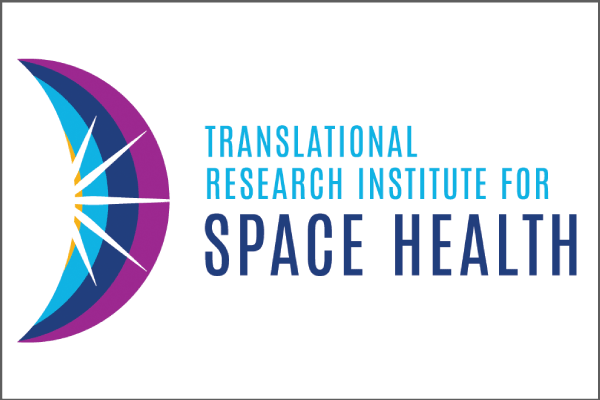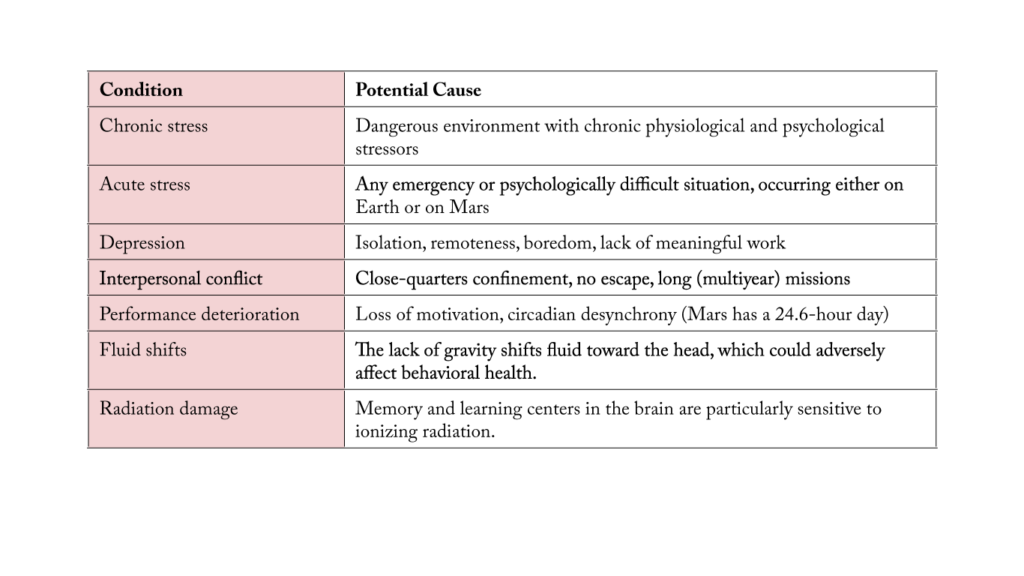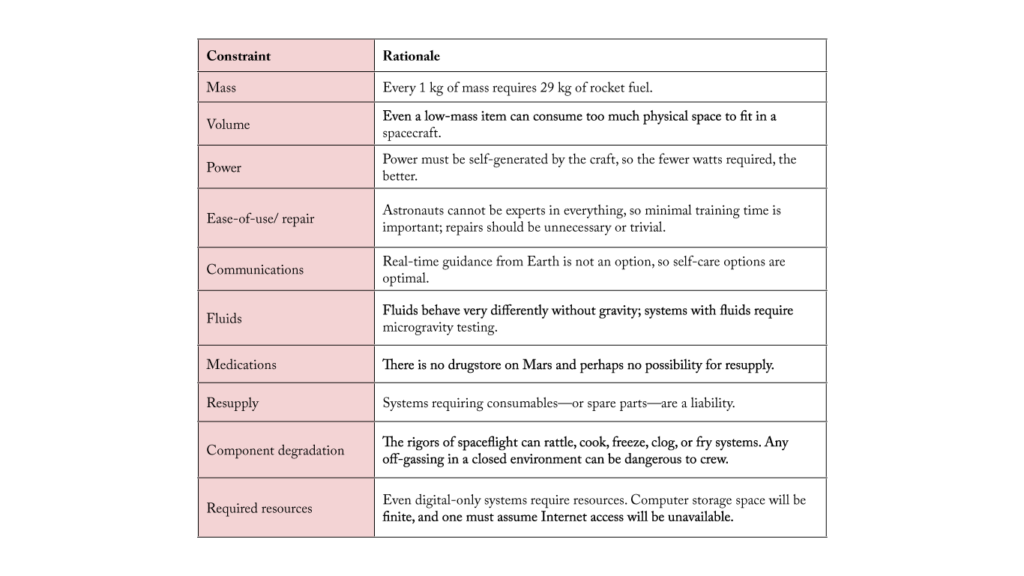Featured
How Do We Get to Mars? (And How Do We Stay Psychologically Healthy in the Process?)

Imagine yourself on the surface of Mars, one of the first humans to successfully make the trip to an entirely different planet. You look to the horizon and take the picture of Earth above. Although you’ve trained for nearly every eventuality, it suddenly hits you with more force: Earth is very far away, and so is nearly everything comforting. Your friends, family, and favorite places are there, along with the sound and smell and feel of rain and the ocean and wind blowing through the trees. Then you remember that even “phoning home” is not possible—at least not the way one normally thinks of it. As the distance between you and Earth increased over the 6-month transit to Mars, communication lags also increased: from a manageable few seconds to delays that simply prohibit real-time conversations. Even at the speed of light, signals between Earth and Mars take between 3 and 22 minutes one way. And that assumes communication is possible at all, since blackouts occur for multiple reasons. Your sense of remoteness and isolation has jumped tenfold.

Along with this extreme isolation, you also have to worry about the physical dangers. These include the lack of an atmosphere, high exposures to radiation, and reduced gravity that weakens muscles and bones and cardiovascular systems. Health risks are paramount, seeing as your Earth-based medical care is a minimum of 56 million kilometers and 6 months away. Even the habitat that keeps you alive has the potential to be dangerous—toxic exposures or fire in a completely closed system are much more problematic than in any normal home.
These hazards—radiation, isolation, distance from Earth, altered gravity, hostile and closed environments—lead to the many health risks associated with spaceflight. Perhaps one of the biggest concerns that NASA has for astronauts embarking on an exploration mission to Mars, however, is psychological and behavioral health. Astronauts who have flown on the International Space Station can quickly list those activities during their flight that were key to maintaining behavioral health during their flight. They could view and photograph Earth, pick up the phone and call family and friends, enjoy special video conferences with celebrities and schoolchildren. They had the “surprise” of a favorite meal or dessert (typically thanks to a resupply vehicle), various exercise options (although the amount needed to maintain physical health wears on some), and even weekly private psychological conferences with ground medical personnel.
Related: “From Antartica to Mars,” also from the May/June Observer
With the exception of exercise, none of these psychological supports will be available on exploration missions to Mars. From your view on Mars, Earth is a tiny dot. Phone and videoconference calls will become asynchronous video or audio file-exchange activities. And resupply will be rare or nonexistent.
So, how can NASA keep astronauts psychologically healthy and operating at peak performance during Mars missions that are likely to last 30+ months?

Enter TRISH—and Psychological Scientists
The Translational Research Institute for Space Health (TRISH) is a Baylor College of Medicine-led consortium with the California Institute of Technology and the Massachusetts Institute of Technology. Charged by NASA (nasa.gov/hrp/tri) via a cooperative agreement, TRISH seeks and funds new health technologies to predict, protect, preserve, and restore astronaut health during deep-space exploration missions. TRISH’s mission requires a holistic and overarching approach to connect two critical groups: researchers who may not be aware that their research is exactly what NASA is looking for and experienced investigators who have a history with NASA research.
Partnered with NASA’s Human Research Program, TRISH focuses specifically on the challenges of human deep-space exploration. We at TRISH want to find and fund disruptive, breakthrough approaches that reduce risks to human health and performance. These approaches include monitoring, detection and diagnosis, countermeasures (i.e., therapies), prediction and prophylactic countermeasures, as well as both experimental work and technology development.
How does all this relate to psychological science? To address NASA’s behavioral health risks, TRISH needs experts in behavioral health maintenance and management to invent and validate breakthrough approaches for use in spaceflight. (See Table 1 for a few specific concerns regarding behavioral health during exploration spaceflight, and find a more detailed discussion of these concerns at NASA’s Human Research Roadmap in the resource list.) These and other behavioral health concerns, which can arise from the various hazards of spaceflight, will likely be exacerbated by the loss of critical behavioral health supports that astronauts currently rely on when flying aboard the International Space Station. Psychological scientists are well versed in both the detection and management of behavioral health conditions; many either use or develop technologies and unique approaches as part of their daily work. It is this expertise—new methods for maintaining psychological and behavioral health, as well as for mitigating psychological and behavioral health challenges that arise—that TRISH is seeking on NASA’s behalf.
The 6-month transits to and from Mars will likely represent the most confined portion of the trip, and hence the greatest risk, but the expected 18-month stay on the surface (because of orbital mechanics and the varying distance between the Earth and Mars) poses daunting behavioral health challenges as well.
On March 12, 2020, TRISH released an industry solicitation seeking just such capabilities (spacehealth.bcm.edu/prog/industry_program_2020). Open until June 26, the solicitation covers these and other example areas of interest:
- Unobtrusive monitoring (i.e., noncontact or minimal-contact sensors) that can be used to accurately assess and/or monitor an individual’s behavioral health status.
- Closed-loop approaches that combine ongoing monitoring with countermeasures that are deployed as needed to continually “nudge” individuals toward more optimal or healthy states.
- New stress and anxiety monitoring and countermeasures for the completely new and dangerous environment of deep space.
- Methods for optimizing asynchronous communications in the face of 3- to 22-minute one-way communications delays.
- Brain-computer interfaces for enhancing memory and/or cognitive performance.
- Investigations into how approaches to improve health span may be relevant to behavioral health and performance.
TRISH is open to other research targets as well, particularly approaches that can be used or adapted to address multiple behavioral health concerns. The current solicitation is focused on companies (see the solicitation for detailed eligibility requirements), but applicants often include academic collaborators. And because of the tremendous challenges provided by NASA’s behavioral health risks, TRISH is broadly interested and has various additional funding programs for academic and other types of applicants (see resource list at end).
In terms of resources to meet this challenge, NASA does not plan to have a psychologist or psychiatrist on a Mars crew. Thus, all supports for behavioral health need to be brought along in some other form. And because of the difficulty of lifting items off planet Earth, “packing for Mars” becomes a challenge. Table 2 provides a number of key considerations that apply to items taken aboard an exploration spacecraft. Most of the limitations relate to the difficulty of launching items into space (requiring minimal mass and volume), the remoteness of exploration flights (limited communications and resupply), and the unique environment (fluids, degradation). While Mars-mission design plans are still being developed, the exploration medical kit could be as small as two shoeboxes. That space must contain everything for medical care: from bandages to drugs, medical devices to disposables. Regardless of shoe size, that is not a lot of space, and hence components of the medical kit that can help with multiple medical conditions or be used in various settings are highly favored.
As we think ahead about the first missions to Mars, we Earth creatures are likely to be caught up in the tremendously exciting event, with much press coverage and ongoing attention on the crew and fanfare upon their return. In fact, the isolation may be considered a bit of a relief from the media blitz, which could lessen the psychological concerns in crews that fly first. As shown during the Apollo missions from 1968 to 1972, however, this novelty effect may wear off after the first few missions—to the point where public interest becomes minimal while the dangers and risks remain high. How do we ensure psychological and behavioral health on exploration missions not just during the first mission, but on later missions as well? That too is of interest to TRISH.
To address NASA’s behavioral health risks, TRISH needs experts in behavioral health maintenance and management to invent and validate breakthrough approaches for use in spaceflight.
Maintaining behavioral health is a major challenge here on Earth. Even in ordinary times, without the mandatory social distancing necessitated by the COVID-19 pandemic, isolation and confinement have negative effects on behavioral health for multiple subgroups of the population. Maintaining behavioral health throughout a 30+ month Mars mission will be an exceptional challenge. Neither NASA nor TRISH can meet this challenge alone; we need help from both industry and academia to bring and test the best ideas and generate solutions. For those with disruptive ideas on how to help astronauts cope with these myriad challenges, we hope that you will work with us to provide solutions. We strongly encourage you to lend your expertise to NASA’s space program.
Table 1: Psychological/behavioral health concerns in exploration spaceflight

Table 2: Constraints relevant to systems used in spaceflight

Maintaining and Optimizing Performance in Novel Contexts
Mission success is paramount in spaceflight. It requires every crew member to consistently perform at a very high level, cognitively and behaviorally, particularly in high-pressure situations. This can be an enormous challenge over the course of a 3-year Mars mission, considering the constellation of potential psychological and physiological stressors that astronauts might encounter in exploration spaceflight. Novel challenges require the adaptation of approaches and the use of novel and disruptive techniques to maintain and optimize behavioral performance.
For example, the basal ganglia and hippocampus are essential structures in learning and memory that are also particularly vulnerable to radiation exposure and chronic stress. In addition, spaceflight often provides disruptive circadian cues that can interfere with internal clocks and hence performance. Mars’s 24.6-hour rotation period, for instance, means a 40-minute daily time shift relative to your internal clock. At the other extreme, astronauts on the International Space Station experience 16 sunrises and sunsets every day.
Given these concerns, TRISH supports a number of brain-stimulation approaches to help maintain and optimize behavioral performance, particularly with regard to functions critical to spaceflight. These include executive functioning, memory, learning, decision making, risk taking, and complex sensorimotor tasks.
Individual and Team Psychological Resilience
It might seem obvious that astronauts would require high psychological resilience to the kinds of challenges they might encounter in space exploration. However, in a small Mars crew of 4-6 individuals, the selection requirements are already immense. For instance, a crew typically needs a pilot, a physician, a medic, a geologist, and an engineer at a bare minimum, with expertise in life-support systems, spacesuit systems, propulsion systems, electronics, computers, software, medical equipment, and many more domains. Further, to reduce the likelihood of serious medical issues far from home, astronauts also need to be exceptionally healthy.
Given these absolute requirements, additional selection criteria are often not feasible. But can psychological resilience be trained? If so, how and how quickly, considering that the intensive 18-month training period prior to a mission allows only about 40 hours of medical training? In addition, is it sufficient to have a collection of resilient individuals, or must team resilience be trained separately? These are all key questions for which TRISH is seeking breakthrough approaches.
Resources and Related Reading
Information about applying to the current TRISH Industry solicitation (open until June 26, 2020)
Information on other TRISH funding and related programs
More general information on the risks in NASA’s Human Research Program.
Information on NASA’s concerns and evidence about behavioral health in spaceflight





Comments
Team resilience will require learning to learn with others in operational situations and ultimately in extremis. There are strong foundations and points of departure for this capability in medical training and military training that are more of an art than a science. A holistic approach to instructional design for continual development of collective intelligence is needed to make team resilience at once more situated and more rigorous.
APS regularly opens certain online articles for discussion on our website. Effective February 2021, you must be a logged-in APS member to post comments. By posting a comment, you agree to our Community Guidelines and the display of your profile information, including your name and affiliation. Any opinions, findings, conclusions, or recommendations present in article comments are those of the writers and do not necessarily reflect the views of APS or the article’s author. For more information, please see our Community Guidelines.
Please login with your APS account to comment.